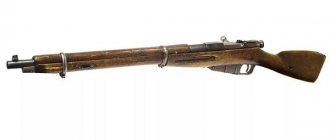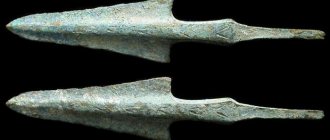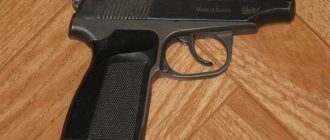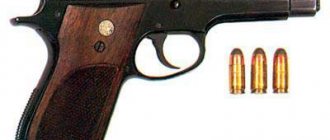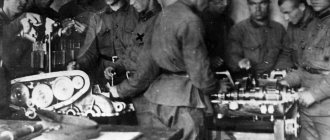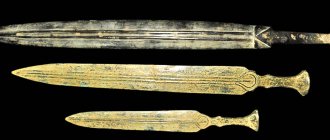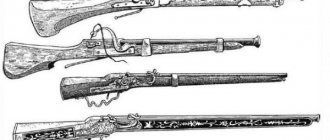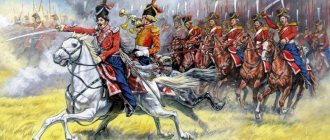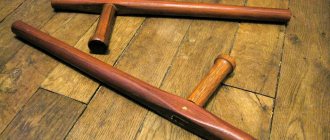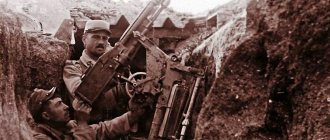There is probably no person who has not at least once heard the word musket, and even more so the word “musketeers” derived from this weapon. By the way, this word has brought historical confusion to humanity. Thanks to the writer Dumas and his musketeers, humanity has taken root in the misconception that France is considered the birthplace of muskets, but these firearms were not invented by the French, although later they had a hand in the musket in terms of its improvement.
How did the first muskets appear?
In the mid-16th century, a firearm called the arquebus arose, which can be considered the ancestor of the classic musket. For some time, arquebuses were considered a formidable weapon, but it soon became clear that the arquebus was an unreliable weapon. The bullets fired from the arquebus, due to their low weight (no more than 20 grams), as well as their modest caliber, were powerless against enemy chain mail and armor, and loading the arquebus was a long process. It was necessary to invent new, more effective firearms.
And such a weapon was invented. History assures us that the first long-barreled gun with a wick-lock, later called a musket, appeared in Spain. History has preserved the name of the gunsmith who invented the musket. This is a certain Mocheto, who lived in the Spanish city of Veletra.
The first musket had a long barrel - up to 150 cm. Thanks to the long barrel, the caliber of the musket also increased. The new gun was able to fire new charges with a larger amount of gunpowder, which allowed the bullet to fly further and at greater speed, resulting in a greater stopping power for the bullet. Such a bullet could no longer be stopped by chain mail and armor.
The first samples of muskets were quite heavy (up to 9 kg), and therefore it was difficult to carry them - the muskets were fired from previously prepared positions. And still, shooting from them was not an easy task: when firing, the musket had a strong recoil, and loading it required time and skill. Soldiers of European armies armed with muskets (primarily Spain, Germany and France - as the most powerful powers of the Middle Ages) represented a formidable force.
Why bite the cartridge
Perhaps the most famous flintlock weapon is the British land musket of 1722, nicknamed the Brown Bess. The wooden stock of the musket was brown, and the barrel was often covered with the so-called “rusty” varnish. “Dark Bess” was used in Britain itself, in all its colonies and was in service until the middle of the 19th century. This weapon did not have any outstanding characteristics, but gained its fame due to its wide distribution. The singer of British militarism and colonialism, Rudyard Kipling, even dedicated one of his poems to the brown musket - it is called Brown Bess. In the 1785 British Dictionary of the Vulgar Tongue, the expression “to embrace Dark Bess” means “to serve as a soldier.”
Experts call the French musket of 1777 the best flintlock gun. By that time, the engineer and fortification master Marquis Sebastien Le Prêtre de Vauban had improved the flintlock and invented the bayonet tube, which made it possible to shoot with a fixed bayonet - before that the bayonet was inserted into the barrel. With this gun, French infantrymen went through all the wars of the Revolution and the Empire. A shotgun with a Vauban lock was almost immediately adopted by all European armies. The Russian musket of the 1808 model was essentially a copy of the French gun with a slightly modified caliber.
British Brown Bess flintlock musket
Brown Bess. Photo: americanlongrifles.org
The impact lock and development of the loading algorithm have significantly increased the rate of fire of muzzle-loading shotguns. Historians claim that 17th-century Prussian infantry fired up to five shots per minute with four reloads, and individual riflemen fired up to seven shots with six reloads.
To speed up loading, gunpowder, wad and bullet were combined in one paper cartridge. The French manual for loading weapons included 12 commands. Briefly, the process looked like this: the soldier put the trigger on the safety cock, opened the cover of the priming shelf, bit into a paper cartridge, poured some of the gunpowder onto the shelf, and then closed it. He poured the remaining gunpowder into the barrel, sent a paper cartridge with a bullet there - the paper served as a wad, nailed the bullet with a ramrod, then cocked the hammer. The gun was ready to fire.
By the way, the paper cartridge played a cruel joke on the British - it is believed that it was this that served as the reason for the sepoy uprising of 1857-1859 in India. In February 1857, the 34th Bengal Regiment of Native Infantry heard a rumor that the casing of the new paper cartridges was impregnated with either cow or pork fat. The need to bite such cartridges offended the religious sentiments of Hindus and Muslims. One of the native soldiers announced that he would not bite the cartridge, and when the regimental lieutenant arrived to investigate the incident, the native shot at him, wounding his horse.
How to load a musket
Each of us has probably seen in films exactly how muskets were loaded. It was a long, complicated and tedious procedure:
- They loaded the musket through the muzzle;
- Gunpowder was poured into the barrel in the amount necessary for the shot (according to the shooter). However, in order not to make a mistake in the dose of gunpowder during the battle, the powder doses were measured in advance and packaged in special bags called chargers. These same charges were attached to the shooter’s belt during shooting;
- First, coarse powder was poured into the barrel;
- Then finer gunpowder, which ignited more quickly;
- The shooter pushed the bullet into the table with the help of a ramrod;
- The charge was pressed against a constantly smoldering wick;
- The ignited gunpowder threw a bullet out of the barrel.
It was believed that if the entire charging procedure takes no more than two minutes, then this is wonderful. In this case, it became possible to fire a salvo first, which often guaranteed victory in the battle.
Heroes of the Northern War
Contrary to the stereotype, Peter I did not abolish the Streltsy because of the riot of 1698 (although, of course, he did not favor them). It’s just that with his new regular army, already armed with firearms, this semi-regular army looked rather pale. And yet the archers managed to take part in Peter’s main war, the Northern War. They fought near Narva (1700), at Erestfer (1701), at Hummelshof (1702), heroically at Fraustadt (1706) and in other places. Near Poltava (1709) they were part of the Rentselev, Yamburg and Kargopol regiments, fought valiantly in the garrison of a fortified camp and on redoubts and did not retreat.
There are no archers in the pictures of the battle of Poltava. (sama-zhizn.ru)
In the battles of the Northern War, the archers proved their combat effectiveness. And after the battle, the archers did not disappear anywhere: they were simply transferred to new regiments, and they continued their service in them. And still they shot and died for the king.
Features of fighting with muskets
A warrior armed with a musket was called a musketeer. A bullet fired from a musket could win a battle, which, in general, was what happened. When firing from muskets in one gulp, it was possible to lay down a whole line of the enemy at a distance of up to 200 meters. The weight of musket bullets could be 60 grams. Armored knights were knocked out of their saddles with musket bullets.
Still, firing a musket was not an easy task. It took a long time to load the musket. The recoil when firing was such that it could knock the shooter off his feet. To protect themselves, the shooters wore special helmets and also tied a special pad to their shoulder. Due to the difficulty of shooting, there were two people with the musket: one loaded the weapon, the other fired, and the loader supported him so that the shooter did not fall.
In order to make it possible to fire muskets faster, the armies of many countries came up with various tricks. One of these tricks that history has preserved was the following. The musketeers lined up in a square consisting of several ranks. While the first rank was firing, the rest were loading their muskets. Having fired, the first line gave way to another, with loaded guns, and that one to the third, fourth, and so on. Thus, musket fire could be carried out constantly.
In the 16th century, during a battle, musket shooting was the decisive condition for victory. Often the side that was the first to fire a volley at the enemy won. If the first salvo did not give a decisive result, then there was no time to fire the musket again - everything was decided in close combat.
Why did the French hate the royal musketeers?
Surely many have read the magnificent novel by A. Dumas “The Three Musketeers”. Anyone who hasn't read it has definitely seen the films. Brave warriors, loyal friends, fearless heroes - this is how we are used to seeing them. However, the contemporaries of the musketeers would not agree with you. For an ordinary resident, a meeting with a musketeer did not bode well. What don't we know about these famous heroes?
A company of Guards (Royal) Musketeers was created in 1622. It was a selected military unit, a type of mounted infantry, and the personal guard of the monarch. Under Louis XIII, the company numbered 100 people. Later, the number of soldiers constantly increased and under Louis XIV reached 250 people.
These guardsmen participated in almost all conflicts in France and truly earned the reputation of the most desperate unit of the French army. However, in peaceful life they were a real scourge for their fellow citizens. Owners of rented apartments, tavern and brothel keepers, as well as ordinary citizens shuddered at the mention of the word “musketeer.”
In some ways, the royal musketeers were a version of the guardsmen under Ivan the Terrible. The king used them to suppress uprisings and punish undesirable nobles. Using the power and protection of the king, they felt like real masters on the streets of Paris.
They could easily refuse to pay bills in a tavern or store, “take away” the woman they liked, regardless of whether she wanted it or not, start a deadly fight with a passerby if they didn’t like something, etc. Often musketeers specifically went into the city to look for adventure and kill someone in a duel.
In addition, the musketeers' salary was small. For example, the “salary” of a private was only 300 livres per year. It was assumed that only nobles would serve in the guard, which means they did not need money. However, everyone loves money. To compensate for their low salaries, the musketeers “protected” brothels and drinking establishments, engaged in racketeering, made bets or played cards; almost all the musketeers went into debt, which they accumulated and did not repay.
In general, these people were extremely dangerous, restless, and when meeting them, citizens tried to quickly get out of the way.
Double-barreled musket: the history of its appearance
In order to get out of the situation, it was necessary to somehow increase the rate of fire of the musket. However, rapid firing of muskets with a matchlock was impossible. The matchlock musket, due to its design, simply could not fire quickly. It was necessary to invent some new musket that could be fired faster.
The double-barreled musket was invented. The advantage of a double-barreled musket over a single-barreled one was obvious: instead of one shot, it could fire two, that is, shoot twice as fast. It was a kind of weapons revolution, but for unknown reasons the double-barreled musket could not take root in the infantry units of European powers. By the way, it is the double-barreled musket that is the progenitor of our hunting rifle - continuity through the centuries.
Moscow archers in battle - “not sparing the stomach...”
The chronicler wrote: “fiery archers” “are much studied in military matters and do not spare their heads, but at the right time, fathers and mothers, forget their wives and children, and are not afraid of death...”. Russian musketeers have earned a reputation as tenacious warriors. When others fled from the battlefield, the archers continued to fight. They participated in almost all of Russia's wars throughout their existence (from the mid-16th to the early 18th century), and there were many wars, and they suffered losses in each.
Russian musketeers in battle. (vsesovetnik.ru)
You read the descriptions of the death and wounds of the archers and think: maybe it’s better to have no privileges, it’s better to bear the “tax” (pay taxes) and do without the royal salary and beautiful caftans? There is only one life! Let's take one example. In 1656, the archers took part in the siege of Dinaburg (this was another Russian-Swedish war). On July 31, they ordered an assault. The archers and soldiers of the regiments of the “new system” went on an attack on the bastions dilapidated by cannons, in which a small Swedish garrison was waiting for them, and came under fire from heavy fortress rifles (“zatina squeaks”): “the archers, on the order of Poltev, Yushka Lukyanov was shot from the zatinny near his right hand the bone was broken, the arm was cut off; Trofimko Koshirin was shot from the back of his hand; a bone was broken in his left hand, and two fingers were torn off from his right hand; Erka Moiseev’s left arm was broken above the elbow, the back bone was broken...” Despite the losses, the archers climbed onto the fortifications. The Swedes threw stones, grenades and rollers (logs): “...soldier Maximko Mikhailov was sprayed with gunpowder from a grenade in the face and the wound was painful; […] Samsonko Grigoriev was wounded by stones, his teeth were knocked out, his upper lip was broken, his left leg was dented by a roller; […] Ivashko Fektistov was hit on the head with a roller.”
And still the Russians climbed the walls: “On Ivanov’s order, Nelidov, the Pentecostal Petrushka Vasiliev was shot with a musket in the right knee, a bullet in it, and chopped on the head with a sword; […] soldier Matyushka Vaksaev’s teeth were knocked out with a lance; […] soldier Vaska Ondreev’s throat was pierced with a spear...” And so on. Up to 200 people were wounded and killed.
Archers and soldiers burst into the city, and the Swedes laid down their arms. Dinaburg was taken.
Pirate musket - the prototype of a modern pistol
But the double-barreled musket, like the single-barreled one, aroused interest among pirates of the 16th century. In subsequent centuries, until the 19th century, when muskets were replaced by more advanced weapons, and the pirates themselves for the most part sank into historical oblivion, pirate enthusiasm for this did not diminish at all. It was the pirates who, first of all, had a hand in improving muskets and contributing to the appearance of the first pistols.
Unlike the army, the “knights of fortune” were the first to fully appreciate what firearms are, and what advantage they give to those who own them and know how to handle them. Heavy musket bullets could easily disable a merchant ship, making it easy prey for filibusters. In addition, in hand-to-hand combat, a pirate armed with a musket was a very formidable combat unit.
To make it more convenient to shoot from a musket and carry it with them, the pirates thought about improving it. The French sea robbers were the most successful in this. They were the first to think of making the musket barrel shorter, reducing its size and caliber, and equipping the weapon with a handle resembling a pistol grip. The result was an easy-to-handle musket, which became the forerunner of modern pistols and revolvers.
The pirates nicknamed certain versions of the shortened musket blunderbusses. They differed from ordinary muskets in their shortened appearance, as well as the expansion at the end of the barrel. Blunderbuss could fire shotguns and hit several enemies at once. In addition, blunderbusses had a very loud sound when fired, which had a frightening psychological effect on the enemy. By the way, not only pirates, but also civilian ships of that time were equipped with muskets and blunderbuss to suppress mutinies on ships.
"Nomen certe novum": the phenomenon of the arquebus and the musket
The European military campaigns
of 1515–1521 and 1522–1525 demonstrated the growing role of handguns on the battlefield. In technical terms, this period was marked by the fact that new types of such weapons - arquebuses and muskets - acquired great importance. When did they arise, what were they, and how did they spread throughout Europe?
Subject of the question
Between 1500 and 1520, the armies of the Spanish kingdoms were armed with an arquebus and a musket, which became a qualitative leap in the development of both hand-held firearms and methods of their combat use. Arquebus
- This is a relatively light small-caliber gun for targeted shooting.
A musket
is a heavier, large-caliber gun for shooting at protected targets. The arquebus allows for hand-held shooting, the musket is so heavy that shooting from it requires a support - a bipod, a reed, or something similar.
Both arquebuses and muskets are long-barreled guns. They have barrels ranging in length from approximately 50 calibers or more. Both arquebuses and muskets are equipped with matchlocks or wheel locks and triggers. They also have similar stocks with a butt for shoulder rest. Special types of stocks, such as those of serf rifles, are only exceptions. Essentially, the difference between an arquebus and a musket is only in size.
Matchlock musket of unknown origin from the Butten collection with the inscription "1516" on the bar attached above the lock; the inscription font is characteristic of the specified time, although the shape of the wooden stock looks more modern. Full length 1.6 m. Buttin, Gay T.2
The arquebus and musket appeared on the battlefield after 1503 and probably before 1521. It may very well be that new types of weapons undergo combat testing already in the 1512 campaign. Under Ravenna (1512), Pedro Navarro had under his command “50 selected shooters firing from the forts”
. The Spanish infantry at Ravenna almost saved the battle already lost on the flanks with their fire in the center of the position.
During the siege of Prato (1512), the Spanish infantry managed to defeat the fortress garrison in a firefight from an open place and at close range. In 1521, “squeaks shooting from supports”
again noted in documents (du Bellay calls them
“arquebuses”
much later, when this word is already familiar).
“The Faithful Servant” (1527), writing for 1524, speaks of the Spanish “hacquebutiers” and “harquebousiers” shooting stones
[bullets the size]
of jacks.”
Prerequisites for the appearance
It is hardly possible to more accurately determine the moment of the appearance of the arquebus and musket. The "Godfather" of these types of hand weapons is almost certainly the "Great Captain" Gonzalo di Cordova. They were created in order to neutralize the “absolute rulers” of the Western European battlefield of the early 16th century - a detachment of French men-at-arms or a column of Swiss pikemen.
With low shooting accuracy of smooth-bore weapons, it is generally possible to increase the accuracy of individual shooting by lengthening the barrel and improving gun techniques. The effectiveness of group shooting is increased by increasing the number of barrels and organizing salvo fire. Lightening the weapon helps to increase the rate of fire, and reducing the caliber increases the supply of charges carried with you.
On the other hand, the damaging effect of a small-caliber lead (tin) round bullet on armor of the early 16th century is not strong enough. And at that time it was possible to strengthen it only by increasing the caliber and powder charge.
Spanish arquebus and musket, almost certainly made later, closer to the middle of the 16th century. Pieces of wick are clamped in the snakes. Calibers: 16.5 mm and 22 mm; total length: 1.365 m and 1.560 m respectively. Arantegui y Sanz, sheet 24
The arquebus and musket solve these problems by combining technical solutions known in themselves with the quality of metalworking and gunpowder production achieved by the 16th century. “the best Spanish iron in Europe” also plays a role.
.
Performance characteristics
A "typical" arquebus (first half) of the 16th century, as Gilmartin describes it, weighs up to 10 pounds (about 4 kg) and has a caliber of 6 lines (15 mm). The bullet for it is ½-ounce (about 15 g). A “typical” Spanish musket of the same era weighs over 18 pounds (more than 5.5 kg) and has a caliber of 7–8.5 lines, sometimes 9 lines and higher (17.8–21.6 mm; 22.9 mm). The bullet for it is 2-ounce (about 60 g).
In experiments in 1970, the results of which are given by Gilmartin, a lead bullet weighing 890 grains (58 g) was accelerated to a muzzle velocity of 330 m/s with a charge of 14 g of modern black powder. In the 16th century, muskets used a charge of the then less effective gunpowder weighing as much as the bullet itself.
The 16th century musket was capable of penetrating the armor of that time at 100 meters and fatally defeating an unarmored living target (man, horse) at 500 meters. All this was possible if the shooter was lucky with a hit, since the aimed shooting range of a musket, like an arquebus, did not exceed 50 meters (sometimes, however, it is considered equal to 70–80 m). The rate of fire of the musket was slightly lower than that of the arquebus.
A shortened version of the arquebus also appears, a descendant of petrinals and a predecessor of cavalry rifles and carbines - “escopeta” (the name, obviously, from the Italian “schiopetto” - “shortened schioppo”). Around the same time, the first pistols appeared.
Procession across Europe
According to Guilmartin, in the 1520s, “ knew
.”
The same probably applies to the musket - a super-heavy arquebus. Mastering the production of new guns now depends only on the technical capabilities of a particular country, and mastering and developing tactics for use depends on the level of development of military science in the country.
Arrows of the French King Francis I, "shooting in rows"
at Marignano (1515), it is unlikely that arquebuses are used, although there is fire control of the shooters, which increases its effectiveness.
In 1523, “in France one cannot find arquebusiers
[to equip a detachment of five thousand riflemen]
. ”
In 1525, at the Battle of Pavia, the danger posed by archers was ignored by King Francis, which led to disastrous consequences. "Nomen certe novum"
, i.e. “a truly new name” - this is what an eyewitness to the battle, Francesco da Carpi, says about the arquebus.
Spanish small-caliber cannon - "sacabuche" of 1557, in fact - a heavy gakovnitsa. The barrel is forged and welded, length 1.393 m, caliber 35 mm. Wikimedia Commons
In 1527, the order of Francis specifies to have in the army “hacquebuttiers” (harquebus shooters) and “harquebusiers” (arquebus shooters) and pay them in a ratio of 10: 1. In 1544, “the musket was still semi-new”
, and in the arsenals on the northern border there are 10 muskets and more than 800 latches.
In 1518, by decree of the Venetian Council of Ten, arquebuses replaced crossbows in the armament of the war galleys of Venice.
“Old” for the 1520s: cast bronze, approximately 1460–1470, barrel 0.57 m, caliber 16 mm; fuse from above. Barrel weight 4.35 kg. Forrer
While the name "arquebus" spread quickly across European languages in the 16th century, the name "musket" spread more slowly. Perhaps this is because a functional analogue of a musket - a latch - is already available in many countries. In Spain, the predecessor of the musket - the heavy gakovnitsa - "sacabuche" - continues to coexist with it even until the middle of the 16th century.
So, “until the end of the reign of Francis I”
(1540s) the French use hacquebutes as heavy guns, including newly made ones.
Back in 1557, the French “Discourses on Artillery” talk about an “arquebus with a hook”
with a caliber of 10 lines and a bullet weighing 1/7 pound (French measures are about 27 mm and about 70 g), that is, about a hook.
"Arquebus" ("arco buso") from the Di Giorgio manuscript around 1480). Caliber 30 mm, lead bullet 170 g
In Italian lands, the previous names for hand weapons were preserved in the middle of the 16th century. In Biringuccio we find “archibusi e schioppi” (Biringuccio, Venetian edition of 1540), while “archibuso” in Di Giorgio Martini around 1480 is a arquebus with a hook and with a 6-ounce (170 g) bullet, that is, a hook .
German military manuals even before the 3rd quarter of the 16th century (Fronsperger) considered hooks (or “full” hooks - “ganze Hacken”, “einfach Hacken”) to be the main type of hand weapon for a lead bullet weighing ⅛ pound (40–45 g) , which “one person carries and one can shoot”
.
Fronsperger also believes that “double hooks”
(“Doppelhacken”) are necessary -
“up to 4 feet long, which one person wears, and another one is needed to shoot
,” designed for a ¼ pound bullet (80–90 g) and shooting from a gantry machine (“Bock”).
German heavy latch from the beginning of the 16th century on a gantry and a crew of two people. Zeugbuch
In addition, it is prescribed to have “short arquebuses” (“kurtze Büchsen”), which have a barrel 2½ feet long, into which “a small chicken egg can easily fit,” and shoot “hand-held bullets, 12–15 at a time,” as well as themselves handbrake (“Handtgeschütze”) and “half-hook”
(“halbe Hacken”),
“of which there are many names and calibers
.
These are still the same basic ones
types of hand weapons that are considered necessary “A list-memoir of what weapons are needed for a small war in the field,” compiled by Leonard Ecker for the Bavarian Duke Albrecht in 1504.
Moreover, the “doppelgack bullet”
as a caliber measure was known even in 1621 (inventory of firearms from the city of Neustadt in the Zagan district in Silesia), and possibly later.
Double hook with matchlock without trigger. The front and rear sights were attached later. Length 2.015 m, barrel 1.377 m, caliber 26.2 mm. Schön, S. 12
However, Jans, who wrote at the time of young German nationalism, believed that half-hooks were precisely arquebuses, and full hooks were muskets, hinting that the Germans had not invented all this.
In different countries, muskets and (or) arquebuses - that is, this is the general technical solution - throughout the 16th century may be known as “Spanish arquebuses”. Even in 1579–1580, the Nuremberg city arsenal listed “Spanish gakovits” (apparently muskets). In Polish and Western Russian (Lithuanian) sources, the arquebus is called “arkabuz” or “garkabuz”, but also “Spanish handbrake”, and distinguishes it from «
[simple]
handbrake"
. By the way, the Statute of the Grand Duchy of Lithuania of 1588 (reproducing the text of 1566) indicates:
“ I didn’t dare to walk around with greedy other armor, greedy with the river , with the garkab with the zom, and with the lion
».
Or, in a source from 1561:
“ The same people there obliged there , and everyone is responsible for the defense... hooks, handles and sagaydaki and other defense... to the house of their own .
»
Wheel lock
Another important invention of the period under review is the wheel lock. It is generally accepted that its first working example was made in Nuremberg in 1515 (the mechanism is based on 10 parts). However, there is also a version of its Italian origin, based, among other things, on the drawings of Leonardo da Vinci in the Atlantic Manuscript.
Small Spanish arquebus with wheel lock, dated 1531. Calvert, pl. 212
How significant this invention turns out to be can be judged by the fact that Emperor Maximilian (1459–1519) already managed to prohibit “fire weapons that set fire to their own gunpowder.”
In 1532, a similar ban was imposed by the Venetian Council of Ten. However, complexity (knurled wheel, spring, key) and the need for scarce consumables (pyrite) are much more effective in curbing the spread of the wheel lock than prohibitions.
The matchlock would remain the main weapon used in military weapons until the end of the 17th century, when it would be replaced by the flintlock. The wheel lock will become typical for less common weapons: pistols, cavalry and hunting weapons, small-scale, piece or exhibition samples.
Outdated but not forgotten
For the most part, handguns in 1515–1525 were still the same hook and hand grip, known under different names in different countries. And they are not necessarily new designs. The hook of this period weighs from 30 to 50 pounds (9 to 15 kg) and is equipped with a hook. Fire from it is carried out from machines or from a reliable support.
Particularly heavy (“double”) hooks are operated by a crew of two people, similar to anti-tank rifles of the 20th century. The barrel of the hook is iron or bronze, medium or large elongation. May have a matchlock and release devices.
“Old” for the 1520s: German forged iron, approximately 1470–1480, length 1.22 m, barrel 0.515 m, caliber 25 mm; fuse from above. Weight 6.25 kg. Forrer
The handbrake has a medium-length barrel, iron or bronze (“copper”), with a matchlock and a trigger device. The stock either continues the axis of the barrel or is placed under it. Boeheim calls this design a “German stock.”
To summarize, we note that in the field of handguns, the decade between 1515 and 1525 was a time of a qualitative leap. Thanks to the development of industry, technically more advanced arquebuses and muskets began to replace the archaic harks in large numbers. Similar phenomena occurred at the same time in artillery. In an attempt to increase the range and accuracy of fire, European foundries began to lengthen gun barrels, often quite radically. These “long trunks” will be discussed in the next article.
The title illustration uses a fragment of Erhard Schön's engraving "Landsknecht with handbrake" (probably around 1535). The handbrake here is literally called “hand pipe” (“Handrohr”). This is how old, “pre-arquebus” models of hand weapons could be called in the German lands and Scandinavia.
Yuri Tarasevich
/
When guns were small
European artillery of the first half of the 14th century: emergence, distribution and use
- artillery
- technologies
- Middle Ages
Yuri Tarasevich
/
Artillery Revolution
In the 20–30s. In the 15th century, a qualitative leap occurred in European artillery, to which France owed its victory in the Hundred Years' War no less than to Joan of Arc.
- artillery
- technologies
- Middle Ages
Literature:
- Gistarychny elephant of Belarusian language
- Contamine F. War in the Middle Ages. St. Petersburg, 2001.
- Anzeiger für Kunde der deutschen Vorzeit. Band 1. 1853. URL: archive.org/details/anzeigerfurkunde01germ.
- Anzeiger für Kunde der deutschen Vorzeit. Band 22. 1875. URL: archive.org/details/anzeigerfurkunde22germ.
- Arántegui y Sanz DJ Apuntes históricos sobre la artillería española en la primera mitad del siglo XVI. Madrid, 1891. URL: archive.org/details/apunteshistrico00sanzgoog.
- Bonaparte M.‑L. Études sur le passé et l'avenir de l'artillerie. T. 1. Paris, 1846. URL: books.google.com/books?id=0rpf2TsXHz8C.
- Catalog de la collection d'armes anciennes européennes et orientales de Charles Buttin. Rumilly, 1933. URL: gallica.bnf.fr/ark:/12148/bpt6k6524676d.
- Delbrück H. Geschichte der Kriegskunst im Rahmen der politischen Geschichte. Vierter Teil: Neuzeit, Berlin: Georg Stilke, 1920 (Nachdruck Berlin: Walter de Gruyter, 1962). URL: zeno.org/Geschichte/L/Delbr%C3%BCck+Gdk+4.+Teil.
- Forrer R. Meine gotischen Handfeuerröhre // Beiträge zur Geschichte der Handfeuerwaffen. Festschrift zum 80. Geburtstag von Moritz Thierbach. Dresden, 1905. S. 23–31. URL: deutsche-digitale-bibliothek.de/item/T5CBUHARDZ5UZX4XHIH2KL6DAM23GT52.
- Fronsperger L. Kriegsbuch Ander Theyl. Von Wagenburgk und die Feldleger. Frankfurt am Mayn, 1573. URL: https://books.google.com/books?id=XoJfAAAAcAAJ.
- Gay V., Stein H. Glossaire archéologique du Moyen Age et de la Renaissance. T. 2. Paris, 1928. URL: archive.org/details/glossairearcho02gayv.
- Górski K. Historya artyleryi polskiej. Warszawa, 1902. URL: archive.org/details/bub_gb_gvkRAAAAYAAJ.
- Guilmartin JF The weapons of sixteenth century warfare at sea // Gunpowder and galleys: changing technology and Mediterranean warfare at sea in the sixteenth century. Rev. ed. United States Naval Institute, 2003.
- Heilmann J. Kriegsgeschichte von Bayern, Franken, Pfalz und Schwaben von 1506 bis 1651. Band I. Kriegsgeschichte und Kriegswesen von 1506–1598. Munich, 1868.
- Jähns M. Entwicklungsgeschichte der alten Trutzwaffen mit einem Anhange über die Feuerwaffen. Berlin, 1899. URL: archive.org/details/bub_gb_EfzZAuG4RXwC.
- Morin M. The origins of the wheellock: a German hypothesis. An alternative to the Italian hypothesis // Arts, Arms and Armour: An International Anthology. 1979. No. 1. P. 81–99.
- Würdinger J. Kriegsgeschichte von Bayern, Franken, Palestine und Schwaben von 1347 bis 1506. Band II. Kriegsgeschichte und Kriegswesen von 1458–1506. München, 1868. URL: mdz-nbn-resolving.de/urn/resolver.pl?urn=urn:nbn:de:bvb:12-bsb10381114–0.
Further improvement of the musket
Meanwhile, the authorities of the leading European powers were not asleep. Their gunsmiths also began to think about improving the musket. Several European powers have achieved impressive results in this matter.
The Dutch were the first to succeed. Their craftsmen designed lighter muskets. Troops armed with such muskets were more mobile, and the muskets themselves became easier to fire. In addition, the Dutch improved the musket barrel by producing musket barrels from soft steel. As a result, musket barrels no longer exploded when fired.
German craftsmen also made a significant contribution to the improvement of the musket. They improved the firing mechanism of the musket. Instead of the matchlock method of shooting, the flint method appeared. The flintlock gun, which replaced the matchlock, was a revolution in the development of weapons in medieval Europe. The lever in the wick mechanism was replaced by a trigger, which, when pressed, released the spring with the flint, the flint hit the arm, resulting in a spark being struck and igniting the gunpowder, which, in turn, ejected the bullet from the barrel. It was much easier to shoot from a flintlock than from a matchlock.
The French were not far behind. First, they changed the butt of the musket: it became longer and flatter. Secondly, they were the first to equip muskets with bayonets, as a result of which muskets could be used as edged weapons. Thirdly, they installed a battery lock on the gun. Thus, the French musket turned into the most advanced firearm at that time. As a result, the flintlock gun replaced the matchlock. In fact, it was Napoleon’s army that was armed with French flint muskets, as well as the Russian army that opposed it.
The main parts of the musket remained unchanged until the very end of its existence. Some individual parts were modified at different times, but the principle of operation itself did not change. This applies to such parts as the butt, stock, working mechanism.
Musket - infantry forces and weapons of brave soldiers
The advent of black powder marked the beginning of the combat use of firearms. Along with bows and crossbows, the first samples of handguns began to be supplied to European armies, but the first battles in which small arms took part did not demonstrate their high combat characteristics. The first arquebuses did not shoot well. There was no need to talk about the accuracy of the shot. In addition, preparing the weapon for a shot required quite a lot of time, not to mention the time required for the next reload. At first, arquebuses became the main weapon of shooters in European armies; a little later, a musket appeared - a much more powerful and heavier weapon.
Musket as part of history and culture
By and large, it was with the musket that the development and improvement of small arms throughout the world began. On the one hand, the musket gave rise to shotguns, rifles, carbines, machine guns and machine guns, and on the other hand, short-barreled weapons like pistols and revolvers. That is why these ancient weapons exhibits are part of history.
On the other hand, muskets are a cultural and collectible value. Having an antique weapon can be the pride of a true amateur collector. In addition, some examples are decorated with precious metals and stones, which further increases their cultural significance.
Moscow archers - rebels and punishers
But it just so happened that the archers were most remembered not for their feats of arms, but for their riots, which had significant political consequences. And indeed: just as the imperial guard was an indispensable participant in palace coups in the 18th century, at the end of the 17th century the archers began to pose a threat to monarchs. This has often happened in history: whoever protects the king dances with him. In addition to small protests, the Moscow Streltsy staged major riots twice, in 1682 and 1698, and the first Streltsy riot ended successfully for them: they achieved their demands and for some time influenced Princess Sophia, making her the ruler of the country. In the second case, everything resulted in the “morning of the Streltsy execution.”
Suppression of the Copper Riot. (history-doc.ru)
But there were completely different pages in the history of the Streltsy. They acted more than once as punitive forces - for example, they suppressed the Copper Riot of 1662. They, as historian A.E. Pisarev writes, became a “strike force” in the war with the rebels under the command of Stepan Razin (1670−1671). For their loyalty to the Tsar, Razin hated them: he destroyed completely 2 regiments put forward against him, and “he, Stenka, ordered them, the archers, to be put in the water, and called them, their archers... butchers: already de us from those butchers, from the Moscow archers , there was no life”; “And he threw the archers into the water alive, tying one person two at a time, and scolding them, stabbed them in the water with darts.” Razin shaved the prisoners' beards "naked". For Russian men of that time, this was a terrible humiliation; shaving then meant two things: either apostasy from Orthodoxy, or homosexuality. So in response, the enraged archers brutally exterminated the Razinites until the end of the war.
Sagittarius: modern reconstruction. (rus-bel.online)
Musket used by pirates
During the era of colonial wars, when the Spanish fleet dominated the sea, muskets, along with pistols and arquebuses, became mandatory weapons on a ship. Handguns were greeted with great enthusiasm in the Navy. Unlike the army, where the main emphasis was on the actions of infantry and cavalry, in a naval battle everything was decided much faster. The contact battle was preceded by preliminary shelling of the enemy from all types of weapons. Firearms played a leading role in this situation, coping with their task perfectly. Artillery and rifle salvoes could cause serious damage to the ship, rigging and manpower.
The muskets did their job perfectly. A heavy bullet easily destroyed the wooden structures of the ship. And close-range shooting, which usually preceded a boarding battle, turned out to be more accurate and crushing. The double-barreled musket came in handy, by the way, doubling the firepower of the naval teams. It is this type of weapon that has practically survived to this day, representing a hunting rifle with two barrels. The only difference is that modern shotguns are loaded by breaking the frame, while muskets were loaded only from the barrel. On muskets, the barrels were located in a vertical plane, while in hunting rifles a horizontal arrangement of barrels was adopted.

